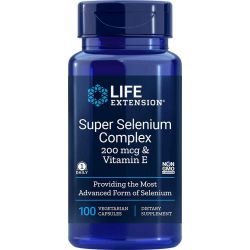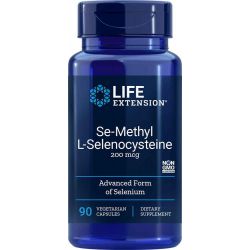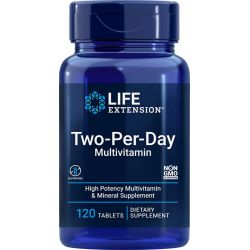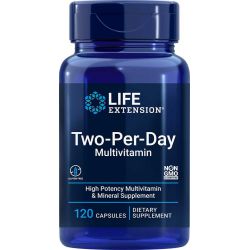Selenium
Named for the moon goddess Selene, the mineral selenium deserves to be treated with reverence. Perhaps no other mineral can match selenium’s versatility and wide array of health benefits. Selenium is crucial for antioxidant defenses, boosts the immune system, and helps prevent cancer in several distinct ways.
Bolstering Antioxidant Defenses
 After antioxidants such as coenzyme Q10 and vitamins E and C neutralize free radicals, they must be regenerated to remain effective as antioxidants. They can be regenerated by the antioxidant peptides glutathione and thioredoxin, which themselves have antioxidant enzymes to regenerate them. Two of these regenerating enzymes are glutathione peroxidase and thioredoxin reductase, both of which contain selenium and depend on selenium activity for their antioxidant functionality. Both the glutathione and thioredoxin systems enhance their own antioxidant activity by inducing the production of other natural antioxidant enzymes,1 including superoxide dismutase.2
After antioxidants such as coenzyme Q10 and vitamins E and C neutralize free radicals, they must be regenerated to remain effective as antioxidants. They can be regenerated by the antioxidant peptides glutathione and thioredoxin, which themselves have antioxidant enzymes to regenerate them. Two of these regenerating enzymes are glutathione peroxidase and thioredoxin reductase, both of which contain selenium and depend on selenium activity for their antioxidant functionality. Both the glutathione and thioredoxin systems enhance their own antioxidant activity by inducing the production of other natural antioxidant enzymes,1 including superoxide dismutase.2
In 1989, the United States National Research Council established a recommended dietary allowance (RDA) for selenium based on maximization of plasma glutathione peroxidase activity.3 Making conservative allowances for body weight and safety, the Council set the RDAs for selenium at 70 mcg per day for adult men and 55 mcg per day for adult women. Despite many discoveries and much research since 1989, the official guidelines for recommended selenium intake have seen little change.
Protecting Against Cancer
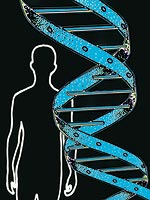 In 1996, the Journal of the American Medical Association published the results of a multicenter, randomized, double-blind, placebo-controlled cancer-prevention trial. The 1,312 study participants took either 200 mcg of selenium a day or placebo over a mean period of four and a half years.4 Subjects who supplemented with selenium had a 37% decrease in total cancer incidence, as well as a 58% reduction in prostate cancer, a 54% reduction in colorectal cancer, and a 30% reduction in lung cancer. This study is a powerful refutation of the contention that dietary supplements offer no measurable health benefit. (After extensive scrutiny of the data, only the evidence for reduction in prostate cancer is now accepted as statistically significant (a 52% reduction). The data still show a total cancer mortality reduction of 41%.5
In 1996, the Journal of the American Medical Association published the results of a multicenter, randomized, double-blind, placebo-controlled cancer-prevention trial. The 1,312 study participants took either 200 mcg of selenium a day or placebo over a mean period of four and a half years.4 Subjects who supplemented with selenium had a 37% decrease in total cancer incidence, as well as a 58% reduction in prostate cancer, a 54% reduction in colorectal cancer, and a 30% reduction in lung cancer. This study is a powerful refutation of the contention that dietary supplements offer no measurable health benefit. (After extensive scrutiny of the data, only the evidence for reduction in prostate cancer is now accepted as statistically significant (a 52% reduction). The data still show a total cancer mortality reduction of 41%.5
Selenium has many diverse anti-cancer benefits, with effects on oxidative stress, DNA methylation and repair, inflammation, cell apoptosis and proliferation, carcinogen detoxification, hormone production, angiogenesis, and immune function.6
Cancer sometimes begins with DNA mutation. DNA is normally protected from cancer-causing substances by methyl groups, but selenium deficiency (like folic acid deficiency) can result in decreased DNA methylation and therefore increased DNA damage and mutation.7,8 Selenium also promotes the activity of the p53 protein, often called “the guardian of the genome.” Well over half of all cancers exhibit evidence of defective p53 protein. When DNA is damaged, p53 either stimulates DNA repair or causes cells to self-destruct (apoptosis) if the DNA damage is irreparable. The thioredoxin reductase system promotes p53 induction of DNA repair enzymes.9 Cells exposed to selenomethionine have shown a threefold increase in p53 activity.10
Healthy wound healing involves a well-coordinated immune/ inflammatory response. Neutro-phil and macrophage immune system cells enter the wound and fight bacteria by creating toxic free radicals such as hydrogen peroxide, peroxynitrite, and the hydroxyl radical. Antioxidant enzymes like selenium-containing glutathione peroxidase and thioredoxin reductase protect neutrophils, macrophages, and other tissues from the free radicals that are created to destroy pathogens. Macrophages release growth factors to promote tissue re-growth.
With chronic inflammation, however, these natural mechanisms run amok in cycles of tissue regeneration and destruction, creating an environment conducive to cancer development.11,12 Continuous exposure to free radicals such as peroxynitrite leads to DNA mutation. Growth factors from macrophages promote proliferation of new cancer cells. An estimated 15% of cancers are attributed to inflammation associated with chronic infections, such as hepatitis, papillomavirus, and the gastric bacterium Helicobacter pylori.13 Non-infectious causes of chronic inflammation such as tobacco smoke and asbestos also contribute significantly to cancer.
Selenium compounds have been shown to block substances inducing DNA expression of genes that can worsen the inflammatory response.14,15 Selenium compounds are likewise very effective in protecting cells from peroxy-nitrite-induced DNA damage.16,17
Strengthening Immune Response
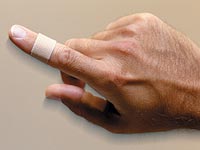 AIDS patients who are selenium deficient are nearly 20 times more likely to die from HIV-related causes than patients with adequate selenium.18 Selenium deficiency increases the virulence of viral infection by causing a more pro-inflammatory immune response.19,20 Neutrophils with reduced glutathione peroxidase due to selenium deficiency are less able to defend themselves against the free radicals they release on to pathogens.21-23
AIDS patients who are selenium deficient are nearly 20 times more likely to die from HIV-related causes than patients with adequate selenium.18 Selenium deficiency increases the virulence of viral infection by causing a more pro-inflammatory immune response.19,20 Neutrophils with reduced glutathione peroxidase due to selenium deficiency are less able to defend themselves against the free radicals they release on to pathogens.21-23
An experiment with aged mice showed that supplementation with above-normal levels of selenium could restore immune cell multiplication caused by antigens to the levels seen in young adult mice.24 Previously, the same researchers had shown that increasing selenium above normal levels in young adult mice increased the bacteria-killing activity of spleen lymphocytes by 22.3%.25 Humans who supplemented with 200 mcg per day of selenium for eight weeks showed a 118% increase in lymphocyte-mediated tumor cytotoxicity and an 82% increase in natural killer-cell activity.26
The selenium-containing iodothyronine deiodinase enzyme converts thyroid hormone from its inactive (T4) form to its active (T3) form. Thyroid problems have been linked to selenium deficiency.27 T3 normally controls the rate of metabolism and the activity of many other hormones. Although most T3 production occurs in the liver, the thymus gland (which produces T-cells) has a local form of iodothyronine deiodinase, which indicates selenium’s importance for the development and function of thymic cells.28
The major non-cardiac cause of death in American hospitals is sepsis due to infection, resulting in more than 100,000 deaths per year in the US. Two thirds of those cases occur in patients who have been hospitalized for other conditions. Selenium not only protects against sepsis by boosting the immune system, but also acts directly against bacterial lipopolysaccharide, a large molecule that contributes significantly to death due to bacterial toxins.29 Elderly people worried about the risk of hospital infections should also consider selenium supplementation as part of their protection against influenza.
Effects on Aging and Disease
 Natural selenium-containing antioxidant enzymes such as glutathione peroxidase and thioredoxin reductase have the potential to reduce the effects of free radicals on the aging process. Sulfur atoms in amino acids can cross-link proteins, decreasing enzyme function and increasing the toughness of aging collagen. Thioredoxin reductase is particularly effective in reducing bonds between sulfur atoms.30
Natural selenium-containing antioxidant enzymes such as glutathione peroxidase and thioredoxin reductase have the potential to reduce the effects of free radicals on the aging process. Sulfur atoms in amino acids can cross-link proteins, decreasing enzyme function and increasing the toughness of aging collagen. Thioredoxin reductase is particularly effective in reducing bonds between sulfur atoms.30
Methionine sulfoxide reductase is an unusual enzyme that directly repairs oxidative damage to the methionine residues in proteins. There are two forms of methionine sulfoxide reductase, one of which contains selenium at its active site. Both forms depend on the thioredoxin system for regeneration. Selenium deficiency has been shown to increase protein oxidation in mice.31 Transgenic fruit flies that over-express methionine sulfoxide reductase have shown a 70% increase in life span.32
Selenium deficiency can contribute to osteoarthritis, cardiovascular disease, and infertility.33-37 Selenium protects against toxic metals such as mercury and arsenic.38,39 Selenium deficiency also can lead to epileptic seizures and may even contribute to Parkinson’s disease.40 Thioredoxin is particularly protective against ischemia-reperfusion injury in the brain.41
Dietary Sources and Safety
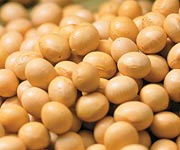 Dietary selenium is primarily inorganic selenite or organic selenomethionine. Dietary selenite is more than 80% bioavailable, while dietary selenomethionine is more than 90% bioavailable.42 Selenomethionine is the major seleno-compound in cereal grains, legumes, soybeans, and yeast.43 Brazil nuts may be the richest food source of selenium, and meats and fish are also good sources. The amount of selenium in fruits and vegetables is typically low, though garlic, onions, leeks, and broccoli florets are sources of the selenium-containing compound Se-methylselenocysteine.
Dietary selenium is primarily inorganic selenite or organic selenomethionine. Dietary selenite is more than 80% bioavailable, while dietary selenomethionine is more than 90% bioavailable.42 Selenomethionine is the major seleno-compound in cereal grains, legumes, soybeans, and yeast.43 Brazil nuts may be the richest food source of selenium, and meats and fish are also good sources. The amount of selenium in fruits and vegetables is typically low, though garlic, onions, leeks, and broccoli florets are sources of the selenium-containing compound Se-methylselenocysteine.
Selenite has greater capacity than selenomethionine to cause DNA damage, but is more effective in preventing cancer.44 Se-methylselenocysteine, however, not only has less capacity for toxicity, but also may be the most effective of the selenium compounds for cancer prevention.45,46 All selenium compounds must be metabolized in the body to selenocysteine before they are incorporated in selenoproteins (including selenium-containing enzymes).44
The selenium content of foods depends greatly on the selenium content of the soil in which they are grown. The Great Plains of the US and Canada are rich sources of selenium, whereas the soils of the northeast, northwest, and Florida have lower selenium content. The selenium content of soil in Europe and the selenium blood levels of Europeans are generally much lower than in North America. Selenium is particularly low in the soils of Finland, New Zealand, and central parts of China.47
Selenium can be dangerously toxic in higher doses, so a “more is better” attitude is especially hazardous with this mineral. Selenium poisoning is associated with liver cirrhosis, neurological damage, and skin lesions. A 1989 study in China estimated 800 mcg per day to be the safe upper limit and reduced that amount to 400 mcg per day to ensure a large margin of safety.48 This recommendation was adopted by the World Health Organization.49 People who take multiple supplements should pay careful attention to ensuring that their total selenium intake does not exceed 400 mcg per day.
Material used with permission of Life Extension. All rights reserved.
1. Hansen JM, Watson WH, Jones DP. Compartmentation of Nrf-2 redox control: regulation of cytoplasmic activation by glutathione and DNA binding by thioredoxin-1. Toxicol Sci. 2004 Nov;82(1):308-17.
2. Das KC, Lewis-Molock Y, White CW. Elevation of manganese superoxide dismutase gene expression by thioredoxin. Am J Respir Cell Mol Biol. 1997 Dec;17(6):713-26.
3. National Research Council: Recommended Dietary Allowances. 10th ed. Washington, DC: National Academy of Sciences; 1989.
4. Clark LC, Combs GF, Jr., Turnbull BW, et al. Effects of selenium supplementation for cancer prevention in patients with carcinoma of the skin. A randomized controlled trial. Nutritional Prevention of Cancer Study Group. JAMA. 1996 Dec 25;276(24):1957-63.
5. Duffield-Lillico AJ, Reid ME, Turnbull BW, et al. Baseline characteristics and the effect of selenium supplementation on cancer incidence in a randomized clinical trial: a summary report of the Nutritional Prevention of Cancer Trial. Cancer Epidemiol Biomarkers Prev. 2002 Jul;11(7):630-9.
6. Taylor PR, Parnes HL, Lippman SM. Science peels the onion of selenium effects on prostate carcinogenesis. J Natl Cancer Inst. 2004 May 5;96(9):645-7.
7. Davis CD, Uthus EO. Dietary folate and selenium affect dimethylhydrazine-induced aberrant crypt formation, global DNA methylation and one-carbon metabolism in rats. J Nutr. 2003 Sep;133(9):2907-14.
8. Davis CD, Uthus EO, Finley JW. Dietary selenium and arsenic affect DNA methylation in vitro in Caco-2 cells and in vivo in rat liver and colon. J Nutr. 2000 Dec;130(12):2903-9.
9. Seo YR, Kelley MR, Smith ML. Selenomethionine regulation of p53 by a ref1-dependent redox mechanism. Proc Natl Acad Sci USA. 2002 Oct 29;99(22):14548-53.
10. Longtin R. Selenium for prevention: eating your way to better DNA repair? J Natl Cancer Inst. 2003 Jan 15;95(2):98-100.
11. Coussens LM, Werb Z. Inflammation and cancer. Nature. 2002 Dec 19;420(6917):860-7.
12. Karin M, Greten FR. NF-kappaB: linking inflammation and immunity to cancer development and progression. Nat Rev Immunol. 2005 Oct;5(10):749-59.
13. Kuper H, Adami HO, Trichopoulos D. Infections as a major preventable cause of human cancer. J Intern Med. 2000 Sep;248(3):171-83.
14. Jozsef L, Filep JG. Selenium-containing compounds attenuate peroxynitrite-mediated NF-kappaB and AP-1 activation and interleukin-8 gene and protein expression in human leukocytes. Free Radic Biol Med. 2003 Nov 1;35(9):1018-27.
15. Yoon SO, Kim MM, Chung AS. Inhibitory effect of selenite on invasion of HT1080 tumor cells. J Biol Chem. 2001 Jun 8;276(23):20085-92.
16. Roussyn I, Briviba K, Masumoto H, Sies H. Selenium-containing compounds protect DNA from single-strand breaks caused by peroxynitrite. Arch Biochem Biophys. 1996 Jun 1;330(1):216-8.
17. Briviba K, Roussyn I, Sharov VS, Sies H. Attenuation of oxidation and nitration reactions of peroxynitrite by selenomethionine, selenocystine and ebselen. Biochem J. 1996 Oct 1;319 (Pt 1)13-5.
18. Baum MK, Shor-Posner G, Lai S, et al. High risk of HIV-related mortality is associated with selenium deficiency. J Acquir Immune Defic Syndr Hum Retrovirol. 1997 Aug 15;15(5):370-4.
19. Beck MA, Levander OA, Handy J. Selenium deficiency and viral infection. J Nutr. 2003 May;133(5 Suppl 1):1463S-7S.
20. Broome CS, McArdle F, Kyle JA, et al. An increase in selenium intake improves immune function and poliovirus handling in adults with marginal selenium status. Am J Clin Nutr. 2004 Jul;80(1):154-62.
21. Boyne R, Arthur JR. The response of selenium-deficient mice to Candida albicans infection. J Nutr. 1986 May;116(5):816-22.
22. Arthur JR, McKenzie RC, Beckett GJ. Selenium in the immune system. J Nutr. 2003 May;133(5 Suppl 1):1457S-9S.
23. Sappey C, Legrand-Poels S, Best-Belpomme M, et al. Stimulation of glutathione peroxidase activity decreases HIV type 1 activation after oxidative stress. AIDS Res Hum Retroviruses. 1994 Nov;10(11):1451-61.
24. Roy M, Kiremidjian-Schumacher L, Wishe HI, Cohen MW, Stotzky G. Supplementation with selenium restores age-related decline in immune cell function. Proc Soc Exp Biol Med. 1995 Sep;209(4):369-75.
25. Roy M, Kiremidjian-Schumacher L, Wishe HI, Cohen MW, Stotzky G. Selenium and immune cell functions. II. Effect on lymphocyte-mediated cytotoxicity. Proc Soc Exp Biol Med. 1990 Feb;193(2):143-8.
26. Kiremidjian-Schumacher L, Roy M, Wishe HI, Cohen MW, Stotzky G. Supplementation with selenium and human immune cell functions. II. Effect on cytotoxic lymphocytes and natural killer cells. Biol Trace Elem Res. 1994 Apr;41(1-2):115-27.
27. Olivieri O, Girelli D, Stanzial AM, et al. Selenium, zinc, and thyroid hormones in healthy subjects: low T3/T4 ratio in the elderly is related to impaired selenium status. Biol Trace Elem Res. 1996 Jan;51(1):31-41.
28. Molinero P, Osuna C, Guerrero JM. Type II thyroxine 5’-deiodinase in the rat thymus. J Endocrinol. 1995 Jul;146(1):105-11.
29. Kim SH, Johnson VJ, Shin TY, Sharma RP. Selenium attenuates lipopolysaccharide-induced oxidative stress responses through modulation of p38 MAPK and NF-kappaB signaling pathways. Exp Biol Med (Maywood.). 2004 Feb;229(2):203-13.
30. Stewart EJ, Aslund F, Beckwith J. Disulfide bond formation in the Escherichia coli cytoplasm: an in vivo role reversal for the thioredoxins. EMBO J. 1998 Oct1;17(19):5543-50.
31. Moskovitz J, Stadtman ER. Selenium-deficient diet enhances protein oxidation and affects methionine sulfoxide reductase (MsrB) protein level in certain mouse tissues. Proc Natl Acad Sci USA. 2003 Jun 24;100(13):7486-90.
32. Ruan H, Tang XD, Chen ML, et al. High-quality life extension by the enzyme peptide methionine sulfoxide reductase. Proc Natl Acad Sci USA. 2002 Mar 5;99(5):2748-53.
33. Kurz B, Jost B, Schunke M. Dietary vitamins and selenium diminish the development of mechanically induced osteoarthritis and increase the expression of antioxidative enzymes in the knee joint of STR/1N mice. Osteoarthritis Cartilage. 2002 Feb;10(2):119-26.
34. Traulsen H, Steinbrenner H, Buchczyk DP, Klotz LO, Sies H. Selenoprotein P protects low-density lipoprotein against oxidation. Free Radic Res. 2004 Feb;38(2):123-8.
35. Alissa EM, Bahijri SM, Ferns GA. The controversy surrounding selenium and cardiovascular disease: a review of the evidence. Med Sci Monit. 2003 Jan;9(1):RA9-18.
36. Neve J. Selenium as a risk factor for cardiovascular diseases. J Cardiovasc Risk. 1996 Feb;3(1):42-7.
37. Ursini F, Heim S, Kiess M, et al. Dual function of the selenoprotein PHGPx during sperm maturation. Science. 1999 Aug 27;285(5432):1393-6.
38. Yoneda S and Suzuki KT. Equimolar Hg-Se complex binds to selenoprotein P. Biochem Biophys Res Commun. 1997 Feb 3;231(1):7-11.
39. Zeng H, Uthus EO, Combs GF, Jr. Mechanistic aspects of the interaction between selenium and arsenic. J Inorg Biochem. 2005 Jun;99(6):1269-74.
40. Schweizer U, Brauer AU, Kohrle J, Nitsch R, Savaskan NE. Selenium and brain function: a poorly recognized liaison. Brain Res Brain Res Rev. 2004 Jul;45(3):164-78.
41. Rybnikova E, Damdimopoulos AE, Gustafsson JA, Spyrou G, Pelto-Huikko M. Expression of novel antioxidant thioredoxin-2 in the rat brain. Eur J Neurosci. 2000 May;12(5):1669-78.
42. Combs GF, Jr., Combs SB. The nutritional biochemistry of selenium. Annu Rev Nutr. 1984;4:257-80.
43. Whanger PD. Selenocompounds in plants and animals and their biological significance. J Am Coll Nutr. 2002 Jun;21(3):223-32.
44. Ip C. Lessons from basic research in selenium and cancer prevention. J Nutr. 1998 Nov;128(11):1845-54.
45. Kim T, Jung U, Cho DY, Chung AS. Se-methylselenocysteine induces apoptosis through caspase activation in HL-60 cells. Carcinogenesis. 2001 Apr;22(4):559-65.
46. Smith ML, Lancia JK, Mercer TI, Ip C. Selenium compounds regulate p53 by common and distinctive mechanisms. Anticancer Res. 2004 May;24(3a):1401-8.
47. Combs GF, Jr. Selenium in global food systems. Br J Nutr. 2001 May;85(5):517-47.
48. Yang G, Yin S, Zhou R, et al. Studies of safe maximal daily dietary Se-intake in a seleniferous area in China. Part II: Relation between Se-intake and the manifestation of clinical signs and certain biochemical alterations in blood and urine. J Trace Elem Electrolytes Health Dis. 1989 Sep;3(3):123-30.
49. World Health Organization. Selenium. In trace elements in human nutrition and health. WHO. 1996;105.22.

